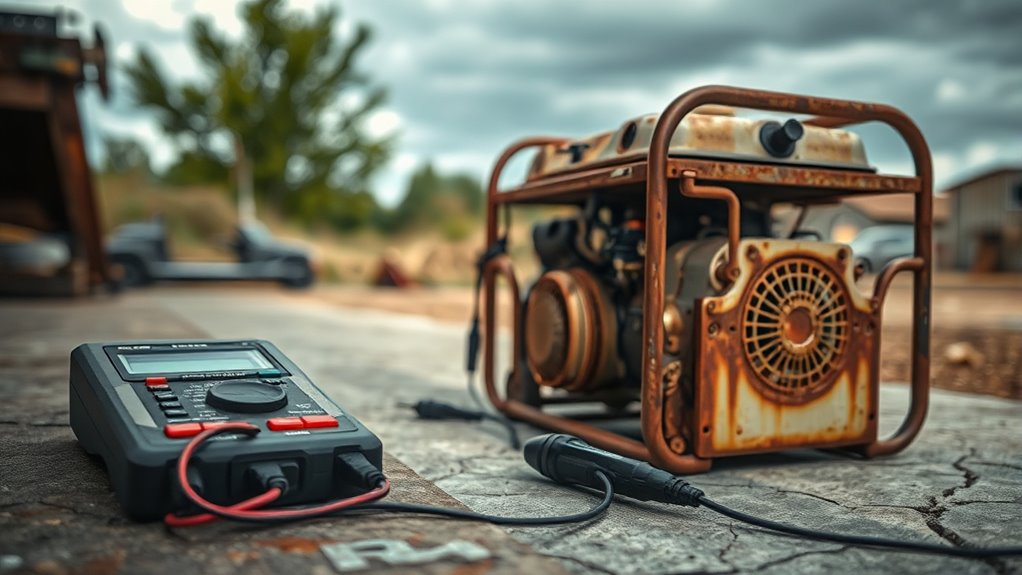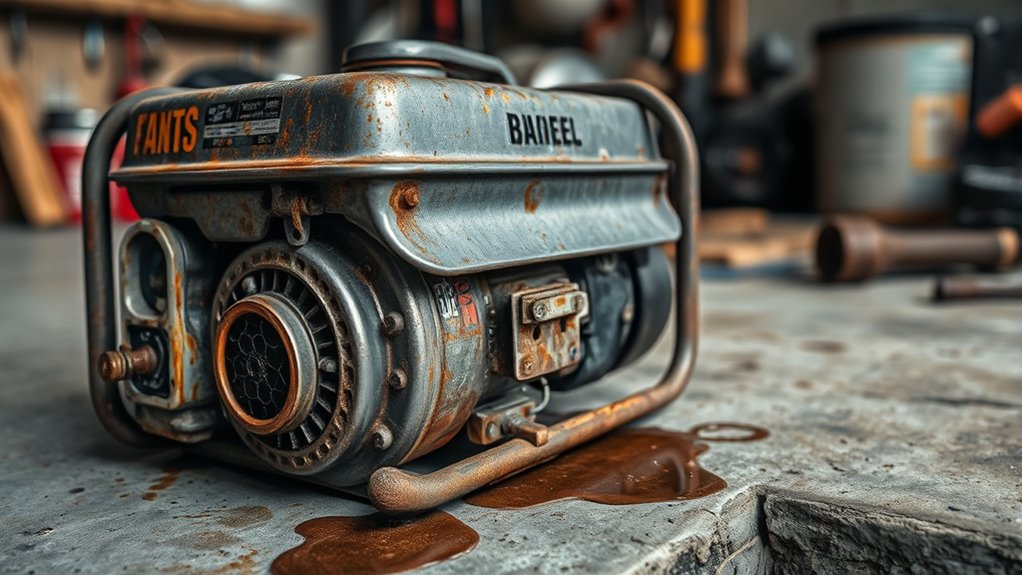Your generator’s lifespan isn’t just about age; it depends on maintenance, usage, and signs of wear. Proper care can extend its life well beyond typical hours, while age alone isn’t a clear indicator for replacement. Watch for performance issues like difficulty starting, increased fuel use, or physical deterioration. By focusing on these signs and maintenance history, you can make smarter replacement decisions—keep exploring to learn more about what truly determines your generator’s longevity.
Key Takeaways
- Generator age alone isn’t a reliable indicator; performance and maintenance history are more important.
- Proper upkeep can extend a generator’s life beyond typical 10,000–30,000 hours.
- Signs like difficulty starting, rising fuel use, or visible wear signal the need for replacement.
- Fuel type, environmental conditions, and usage patterns significantly influence generator longevity.
- Regular performance assessments help determine the right time for replacement, avoiding premature or unnecessary costs.
Common Misconceptions About When to Replace Your Generator

Many people assume that a generator needs replacing solely based on its age, but this isn’t always accurate. Generators can last between 10,000 and 30,000 hours or more with proper maintenance, often surpassing their expected lifespan. Age over ten years isn’t a definitive sign for replacement; how well the generator performs and how often it needs repairs matter more. Signs of wear, like reduced efficiency or increased noise, often indicate mechanical issues rather than age alone. Regular professional assessments help determine whether wear is manageable or if replacement is necessary. Well-maintained generators can operate effectively beyond their expected lifespan, delaying the need for replacement. Proper maintenance significantly extends the lifespan of your generator and ensures it remains dependable during outages. Additionally, understanding the horsepower of your generator can help evaluate whether it still meets your power needs efficiently. Relying solely on age could lead to unnecessary costs or premature disposal of equipment still capable of reliable operation.
Key Factors That Influence Generator Longevity and Performance

The factors that influence your generator’s lifespan and performance extend beyond age alone. Fuel type plays a significant role: diesel generators typically last 15,000 to 30,000 hours due to fewer moving parts and durability, while natural gas units last 10,000 to 20,000 hours, offering a good balance of longevity and cleaner operation. Gasoline generators tend to wear out faster, lasting 6,000 to 10,000 hours, because gasoline degrades quicker and causes more engine strain. Propane models usually last longer than gasoline thanks to cleaner burning. Proper maintenance is essential—regular oil changes, inspections, and professional servicing prevent early failures. Routine maintenance significantly extends generator life, regardless of fuel type. Additionally, fuel efficiency and storage conditions can influence overall longevity, making proper handling and operation crucial for maximizing lifespan. Usage patterns, environmental conditions, and technological advances also impact how long your generator performs efficiently and reliably.
Practical Signs and Indicators for Generator Replacement

Recognizing when to replace your generator is essential for maintaining reliable power and avoiding costly breakdowns. Pay attention to these signs:
- Difficulty starting or operational hesitation, even after maintenance, signals internal issues like worn spark plugs, clogged fuel lines, or battery decline. Fuel efficiency declines over time, requiring more fuel for the same power output.
- Increasing fuel consumption or fuel system problems point to aging components needing replacement.
- Fluctuating power output, surges, or dimming lights indicate declining voltage regulation and internal wear, which can also be influenced by generator load capacity and overall system health.
- Frequent repairs, high costs, and parts unavailability suggest the generator is nearing the end of its useful life.
Additionally, visible signs like rust, cracks, leaks, or corrosion reveal physical deterioration that impacts performance. Monitoring these indicators helps you decide when replacement is the most cost-effective and reliable solution.
Frequently Asked Questions
Can a Generator’s Warranty Influence Its Replacement Schedule?
Yes, your generator’s warranty can influence its replacement schedule. When covered by a warranty, repairs and parts are often paid for, which may delay the need for replacement. Extended warranties can provide even longer protection, encouraging you to keep the unit longer. However, if maintenance isn’t proper or the warranty gets voided, you might have to replace the generator sooner since repairs won’t be covered.
How Does Climate Impact Generator Lifespan and Maintenance Needs?
Climate considerably impacts your generator’s lifespan and maintenance needs. Hot weather increases cooling system strain, speeding up wear, while cold climates make starting harder and can cause lubricant issues. Humidity promotes rust and corrosion, especially near the coast, requiring extra protective measures. Dusty or polluted environments clog filters and degrade parts faster. By understanding your climate, you can schedule proactive maintenance, use appropriate protective coatings, and choose suitable cooling or heating systems to extend your generator’s life.
Are There Specific Signs for Replacing Residential Versus Industrial Generators?
You might worry about missing early signs, but recognizing specific indicators helps prevent costly failures. For residential generators, watch for starting issues or power fluctuations. If your unit shows corrosion, leaks, or excessive wear, it’s time to replace. Industrial generators, on the other hand, signal the need for replacement through frequent breakdowns, declining power quality, or surpassing operational hours. Spotting these signs early keeps your power reliable and safe.
Does Upgrading Generator Components Extend Its Overall Lifespan Significantly?
Upgrading your generator components can substantially extend its lifespan, especially if you target aging parts like batteries, filters, or windings. Regular upgrades prevent early failures and keep the system running efficiently. However, the extent of the lifespan extension depends on the components’ condition and upgrade quality. Combining upgrades with proper maintenance ensures your generator stays reliable longer, potentially adding decades of service before needing full replacement.
How Does Frequency of Use Affect the Timing of Generator Replacement?
Think of your generator like a car engine: frequent use, like regular driving, keeps it in good shape, while neglect leads to early breakdown. Running it intermittently at moderate loads can extend its life, but overusing or underusing accelerates wear. Regular maintenance and proper load management are key. If you use it often, expect more maintenance, but with care, you can delay replacement and keep it running smoothly longer.
Conclusion
Your generator is the heartbeat of your backup power, and knowing when to replace it keeps your home’s safety in sync. Don’t wait for it to sputter or fade—trust the signs and facts, not myths. Think of your generator as a trusted companion on a long journey; with proper care and attention, it’ll carry you through storms. Stay vigilant, and you’ll guarantee your safety remains steady, no matter what comes your way.










